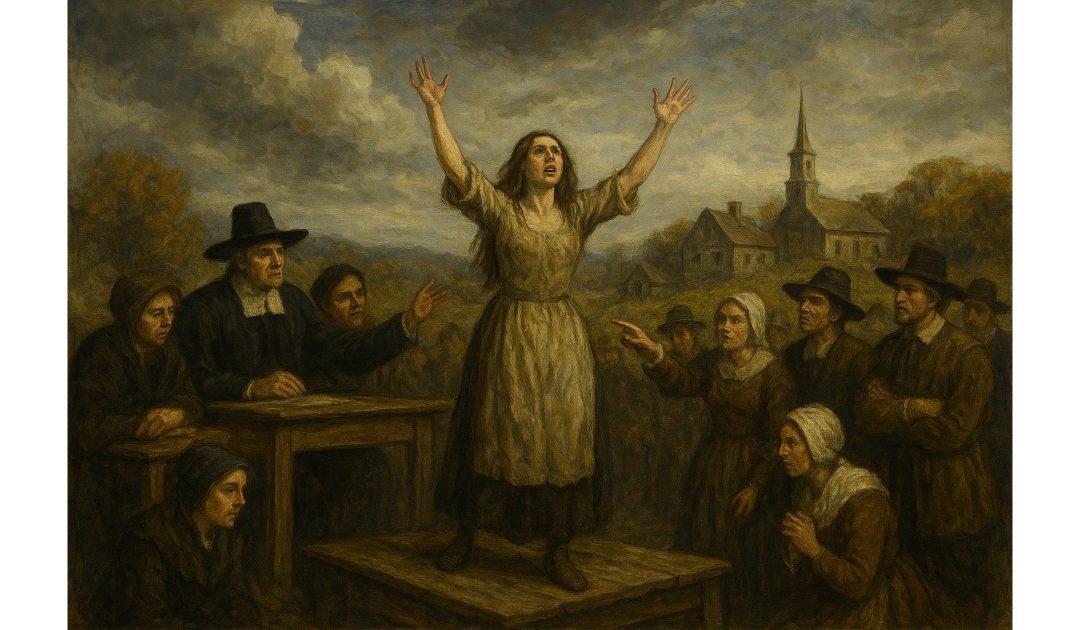On the 12th of October, 1692, the Salem Witch Trials were ended by a letter from William Phipps, the Governor of the Province of Massachusetts Bay. I’ve posted about the Pendle Witch Trial, and Called to Account, the fourth book in the Sir Anthony Standen Adventures, includes a witch trial, and burning of witches. Whilst the book is primarily concerned with anti-semitism, the mindset of the time was that God created a perfect world, and therefore any crisis such as crop failure must be someone’s fault. Witches and Jews were the usual suspects.
The Salem Witch Trials, held in colonial Massachusetts between 1692 and 1693, remain one of the most infamous episodes of mass hysteria in American history. Rooted in superstition, religious fervour, and socio-political tensions, these trials led to the accusation, conviction, and execution of twenty individuals, with several others facing imprisonment under the charge of practising witchcraft.
The backdrop of the Salem Witch Trials was a puritanical society plagued by external threats, including conflicts with Native American tribes and political upheaval in the Massachusetts Bay Colony. The Puritans, who had left England to escape religious persecution, established a strict theocratic society. Within this framework, any deviation from religious norms was often viewed with suspicion and could be construed as consorting with the Devil.
By the late 17th century, Salem Village (now Danvers, Massachusetts) was rife with internal divisions. Socio-economic disparities, land disputes, and rivalries created an atmosphere of distrust. The rigid Puritan ethos, combined with these tensions, laid fertile ground for the witchcraft hysteria to take root.
The trials began in January 1692, when Reverend Samuel Parris’s daughter, Betty, and his niece, Abigail Williams, started exhibiting strange behaviours—fits, screaming, and contortions. A local doctor, unable to find a physical cause, suggested witchcraft. This diagnosis led to a growing panic within the community.
Under pressure to identify the cause of their afflictions, the girls named three women as their tormentors: Tituba, an enslaved woman of South American or Caribbean origin; Sarah Good, a destitute woman; and Sarah Osborne, who rarely attended church. These women were easy targets due to their marginal status in society. Tituba, possibly under duress, confessed to practising witchcraft and claimed there were other witches in the colony, fuelling the hysteria.
As fears escalated, accusations spread rapidly. Neighbours accused neighbours, often driven by personal vendettas or the hope of acquiring land. The legal system, ill-equipped to handle such claims, relied heavily on spectral evidence—testimony that the spirit or spectre of the accused appeared to the witness in a dream or vision. This intangible “evidence” made it nearly impossible for the accused to defend themselves.
Between June and September 1692, the court convicted and executed twenty individuals, most by hanging. Notably, Giles Corey was pressed to death with heavy stones for refusing to enter a plea. Over 200 others faced accusations, and many languished in jail under harsh conditions.
Prominent in the trials were individuals like Judge Samuel Sewall, Magistrate William Stoughton, and Reverend Cotton Mather, who supported the court’s proceedings. Conversely, Reverend Increase Mather, Cotton’s father, grew sceptical of the trials, famously stating, “It were better that ten suspected witches should escape than one innocent person be condemned.”
By early 1693, public opinion shifted. Governor William Phips, influenced by growing scepticism and pleas from respected citizens, dissolved the special court and prohibited the use of spectral evidence. He later pardoned many of the accused and released them from prison.
The colony grappled with the fallout for years. In 1697, a day of fasting and reflection was declared to acknowledge the tragedy. Judges and jurors publicly confessed their errors, and in 1702, the trials were declared unlawful. Compensation was granted to the families of the victims in the years that followed.
The Salem Witch Trials have left an indelible mark on American culture and legal history. They serve as a cautionary tale about the dangers of mass hysteria, scapegoating, and the breakdown of due process. The trials underscore the importance of evidence-based justice and the protection of individual rights against unfounded accusations.
In literature and popular culture, the trials have inspired works such as Arthur Miller’s “The Crucible,” which, while set in Salem, allegorises the anti-communist McCarthy era of the 1950s. The enduring interest in the trials reflects society’s fascination with the interplay between fear, power, and justice.
Today, Salem, Massachusetts, embraces its history, attracting tourists to sites like the Salem Witch Museum and the Witch House. While commercialised, these sites also offer educational insights into this dark chapter, ensuring the lessons of the Salem Witch Trials are not forgotten.

